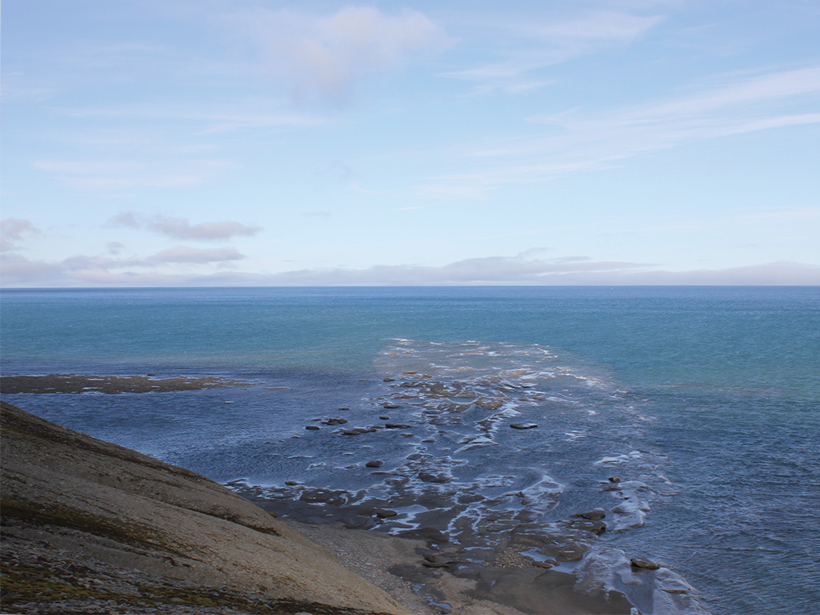A river delta plain nearly 2 million square kilometers in size once dominated the northern shores of ancient Pangaea, according to a recent study. The Triassic Boreal Ocean delta plain, whose deposits are currently located in the Barents Sea, is around 230 million years old and is the largest delta plain, modern or past, known to exist.
“We always knew it was large. There was little doubt about that,” Tore Klausen, lead researcher on the discovery, told Eos. When Klausen and his team began connecting their observations to those from collaborators, “then we started to realize just how large it was.” Klausen is a senior explorationist at Petrolia NOCO AS in Bergen, Norway.
Learning from the Past
Deltas can support large-scale agriculture and have sustained some of the largest ancient civilizations. The Nile delta in Egypt, the Yangtze delta in China, and the Ganges-Brahmaputra delta in India and Bangladesh are a few examples. Many countries today continue to rely on lush and sediment-rich deltas to support agriculture.
“You can use ancient deltas to understand how modern river systems should be behaving.”
But this same propensity for humans to congregate around deltas makes it more difficult for scientists to study how they naturally grow and change.
“Modern river deltas are very controlled and regulated, and this hampers the natural evolution of these delta plains,” said coauthor Björn Nyberg, a sedimentologist at the University of Bergen in Norway. “Over 90% of the world’s population lives within 10 kilometers of a river source.”
But “you can use ancient deltas to understand how modern river systems should be behaving,” he said.
A Delta the Size of Alaska
How does one team map out a delta more than a thousand kilometers across? “We used seismic reflectors, which is essentially like sonar, to look at the different rock layers in the subsurface,” Nyberg explained. The delta’s channels and meanders left behind ribbon-like deposits of sediment with a distinctive seismic signature in the rock record.

The delta “is essentially 10 times bigger than the modern Amazon delta or the Ganges in India. It absolutely out scales any other example that we know of.”
The team combined the seismic data with measurements from boreholes as well as from where the delta deposits lie exposed in rocky outcrops in Svalbard, Norway. Ages from zircons sampled across the region ensured that the deposits were the same age despite being separated by a great distance.
All told, the Triassic Boreal Ocean delta plain spanned at least 1.65 million square kilometers in northern Pangaea. That’s about 1% of the total land area of Earth right now.
“It’s basically the size of Alaska,” Nyberg said. “That is essentially 10 times bigger than the modern Amazon delta or the Ganges in India. It absolutely out scales any other example that we know of.”
Incomplete Puzzle
The team measured past seafloor depths—paleobathymetry—and found that the delta emptied into a very large basin only about 400 meters deep. Most modern deltas exist near the edges of continental shelves that quickly drop to thousands of meters deep, which cuts off delta growth.
A large supply of sediment, monsoon-like rainfalls, and steady sea levels all contributed to the delta’s growth, the researchers said, but the shallow basin was the key to its gargantuan size. The shallow gradient let the delta plain grow uninterrupted for more than a million years.
And the delta plain might have been even larger than Klausen’s team could measure. “We don’t see the end of the delta plain,” Klausen said. “There are time-equivalent deposits in eastern Greenland and Canada, for instance, which are possibly linked to the delta plain.”
“There are likely pieces of the puzzle that still need to be added this story,” he added.
The team published this discovery in Geology on 22 March.
“The Triassic delta plain system built across this shelf region is truly vast,” Elizabeth Miller, a structural geologist at Stanford University in Stanford, Calif., told Eos. This study’s detailed seismic reflection data “allow unprecedented documentation of large-scale depositional systems from Paleozoic to modern times,” according to Miller, who was not involved with this research.
Exciting and Familiar
Beyond its size, one aspect of the Triassic Boreal Ocean delta plain that excited the scientists was its timing.
“The channels split and evolve and are dancing around on the delta plain much like we see today.”
“Right before this, we were coming out of the Permian extinction, the mass extinction which wiped out the majority of life on Earth,” Nyberg said. “Then right after, in the Triassic, you get this perfect set of conditions that’s creating this vast delta plain on the northern coast of Pangea, and it’s one of the only areas that’s very hospitable to life after this mass extinction.”
“One of the things that we’re really excited to look at in the future is what role this massive delta had in evolution and the resurgence of both terrestrial and marine life,” he said.
Despite this ancient delta plain’s oversized footprint, many aspects of it are familiar.
“As you move down the delta plain and start affecting it with tides and standing water, the channels split and evolve and are dancing around on the delta plain much like we see today,” Klausen said. “There is much we can take from the modern to understand the ancient.”
“Apart from the actual size,” he said, “they are not too different.”
—Kimberly M. S. Cartier (@AstroKimCartier), Staff Writer
Citation:
Cartier, K. M. S. (2019), Largest delta plain in Earth’s history discovered in Arctic, Eos, 100, https://doi.org/10.1029/2019EO119681. Published on 01 April 2019.
Text © 2019. AGU. CC BY-NC-ND 3.0
Except where otherwise noted, images are subject to copyright. Any reuse without express permission from the copyright owner is prohibited.

